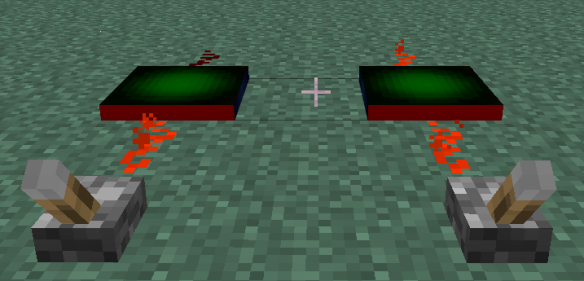As an undergraduate student at RWTH Aachen University, I asked Prof. Barbara Terhal to supervise my bachelor thesis. She told me about qCraft and asked whether I could implement PR-boxes in Minecraft. PR-boxes are named after their inventors Sandu Popescu and Daniel Rohrlich and have a rather simple behavior. Two parties, let’s call them Alice and Bob, find themselves at two different locations. They each have a box in which they can provide an input bit. And as soon as one of them has done this, he/she can obtain an output bit. The outcomes of the boxes are correlated and satisfy the following condition: If both input bits are 1, the output bits will be different, each 0 or 1 with probability 1/2. If at least one of the input bits is 0, the output bits will be the same, 0 or 1 with probability 1/2. Thus, input bits x and y, and output bits a and b of the PR-box satisfy x AND y = a⊕b, where ⊕ denotes addition modulo two. Neither Alice nor Bob can learn anything about the other one’s input from his/her input and output. This means that Alice and Bob cannot use the PR-boxes to signal to each other.
The motivation for PR-boxes arose from the Clauser-Horne-Shimony-Holt (CHSH) inequality. This Bell-like inequality bounds the correlation that can exist between two remote, non-signaling, classical systems described by local hidden variable theories. Experiments have now convincingly shown that quantum entanglement cannot be explained by local hidden variable theories. Furthermore, the CHSH inequality provides a method to distinguish quantum systems from super-quantum correlations. The correlation between the outputs of the PR-box goes beyond any quantum entanglement. If Alice and Bob were to share an entangled state they could only realize the correlation of the PR-box with probability at most cos²(π/8). PR-boxes are therefore, as far as we know, not physically realizable.
But PR-boxes would have impressive consequences. One of the most remarkable was shown by Wim van Dam in his Oxford PhD thesis in 1999. He proved that two parties can use these PR-boxes to compute any Boolean function f(x,y) of Alice´s input bit string x and Bob´s input bit string y, with only one bit of communication. This is fascinating due to the non-signaling condition fulfilled by PR-boxes. For instance, Alice and Bob could compare their two bit strings x and y of arbitrary length and compute whether or not they are the same. Using classical or quantum systems, one can show that there are lower bounds for the number of bits that need to be communicated between Alice and Bob, which grow with the length of the input bit strings. If Alice and Bob share PR-boxes, they only need sufficiently many PR-boxes (unfortunately, for arbitrary Boolean functions this number grows exponentially) and either Alice or Bob only has to send one bit to the other party. Another application is one-out-of-two oblivious transfer. In this scenario, Alice provides two bits and Bob can choose which of them he wants to know. Ideally, Alice does not learn which bit Bob has chosen and Bob does not learn anything about the other bit. One can use a PR-box to obtain this ideal behavior.
An exciting question for theorists is: why does nature allow for quantum correlations and entanglement but not for super-quantum correlations such as the PR-box? Is there a general physical principle at play? Research on PR-boxes could unveil such principle and explain why PR-boxes are not physically realizable but quantum entanglement is.

But now in the Minecraft world PR-boxes are physically realized! I have built a modification that includes these non-local boxes as an extension of the qCraft modification. Each PR-box is divided into two blocks in order to give the two parties the possibility of spatially partitioning the inputs and outputs. The inputs and outputs are provided by using the in-built Redstone system. This works pretty much like building electrical circuits. The normal PR-boxes function similar as measurements on quantum mechanical states. An input is provided and the corresponding random output is obtained by energizing a block (like measuring the quantum state). This can only be done once. Afterwards, the output is maintained throughout the game. To avoid laborious redistribution and replacement after each usage, I have introduced a timed version of the PR-box in Minecraft. To get a better idea of what this all looks like, visit this demo video.
PR-boxes are interesting in particular in multiplayer scenarios since there are two parties needed to use them appropriately. For example, these new elements could be used to create multiplayer dungeons where the players have to communicate using only a small number of bits or provide a combined password to deactivate a trap. The timed PR-box may be used as a component of a Minecraft computer to simplify circuits using the compatibility with clocks.
I hope that you will try this modification and show how they can enhance gameplay in Minecraft! This mod as well as my thesis can be downloaded here. For me it was much fun to go from the first ideas how to realize PR-boxes in Minecraft to this final implementation. Just as qCraft, this is a playful way of exploring theoretical physics.

Pingback: Gamifying Quantum Theory | The Quantum Times